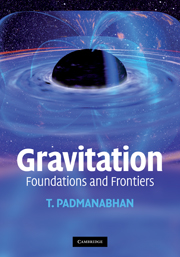Book contents
- Frontmatter
- Contents
- List of exercises
- List of projects
- Preface
- How to use this book
- 1 Special relativity
- 2 Scalar and electromagnetic fields in special relativity
- 3 Gravity and spacetime geometry: the inescapable connection
- 4 Metric tensor, geodesics and covariant derivative
- 5 Curvature of spacetime
- 6 Einstein's field equations and gravitational dynamics
- 7 Spherically symmetric geometry
- 8 Black holes
- 9 Gravitational waves
- 10 Relativistic cosmology
- 11 Differential forms and exterior calculus
- 12 Hamiltonian structure of general relativity
- 13 Evolution of cosmological perturbations
- 14 Quantum field theory in curved spacetime
- 15 Gravity in higher and lower dimensions
- 16 Gravity as an emergent phenomenon
- Notes
- Index
6 - Einstein's field equations and gravitational dynamics
Published online by Cambridge University Press: 05 June 2012
- Frontmatter
- Contents
- List of exercises
- List of projects
- Preface
- How to use this book
- 1 Special relativity
- 2 Scalar and electromagnetic fields in special relativity
- 3 Gravity and spacetime geometry: the inescapable connection
- 4 Metric tensor, geodesics and covariant derivative
- 5 Curvature of spacetime
- 6 Einstein's field equations and gravitational dynamics
- 7 Spherically symmetric geometry
- 8 Black holes
- 9 Gravitational waves
- 10 Relativistic cosmology
- 11 Differential forms and exterior calculus
- 12 Hamiltonian structure of general relativity
- 13 Evolution of cosmological perturbations
- 14 Quantum field theory in curved spacetime
- 15 Gravity in higher and lower dimensions
- 16 Gravity as an emergent phenomenon
- Notes
- Index
Summary
Introduction
We begin this chapter by introducing the action functional for gravity and obtaining Einstein's equations. We then describe the general properties of Einstein's equations and discuss their weak field limit. The action functional and its properties will play a crucial role in Chapters 12, 15 and 16, while the linearized field equations will form the basis of our discussion of gravitational waves in Chapter 9.
Action and gravitational field equations
Let us recall that we studied the scalar and electromagnetic fields in Chapter 2 in two steps. First, in Sections 2.3.1 and 2.4.1, we considered the effect of the field (scalar or electromagnetic) on other physical systems (like material particles). In the second step, in Sections 2.3.2 and 2.7, we studied the dynamics of the field itself, by adding a new term to the action principle. This new term depended on the field and on its first derivatives; by varying the field in the total action we could obtain the dynamical equations governing the field.
In the case of gravity, we have already completed the corresponding first step in the previous two chapters. We have seen that the effect of gravity on any other physical system (particles, fluids, electromagnetic field, …) can be incorporated by modifying the action functional for the physical system by changing d4x to, partial derivatives by covariant derivatives and replacing ηab by gab.
- Type
- Chapter
- Information
- GravitationFoundations and Frontiers, pp. 239 - 292Publisher: Cambridge University PressPrint publication year: 2010
- 1
- Cited by



